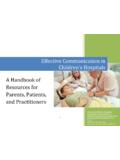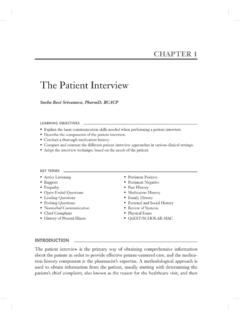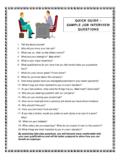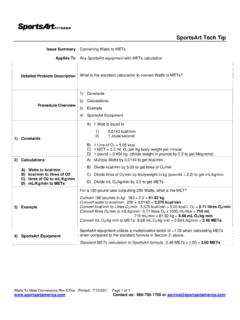Transcription of Training Nurses in Patient Communication …
1 Training Nurses in Patient Communication heather Smith and Harvey Pressman Central Coast Children's Foundation, Inc. Although effective Communication with patients is increasingly understood as a key to effective, Patient -centered care in all health care settings, the quantity and quality of Training that Nurses get in ways to promote and enhance effective nurse : Patient Communication is sadly lacking. This is true in the context of the pre-service Training of Nurses , and it is even more true with regard to the in-service Training and continuing education of Nurses . There are, fortunately, some rare exceptions. This annotated bibliography is intended to provide information about, and connections with, the relatively few publications that contain practical information and ideas about how to do a better job of helping Nurses learn to jointly establish meaning ( , truly communicate) with patients with the wide variety of Communication vulnerabilities and Communication challenges that patients bring with them, or develop in the course of their treatment.
2 Today, as the Joint Commission in the United States moves rapidly forward with new and revised requirements to improve Patient :provider Communication applicable to the hospital accreditation program . (emphasis theirs), it is especially important for those responsible for hospital care, and those responsible for Training Nurses for positions in hospitals, to take a fresh look at the quality and extent of the Training they provide to Nurses in this crucial area. The evidence keeps mounting that Communication barriers, breakdowns and problems are the root cause of more sentinel events, medical errors, unnecessary costs, and inadequate treatments than any other single cause. What is needed now is energetic action by health care decision-makers to move forward more quickly in adopting and adapting some of the ideas contained in the list of publications below.
3 This list is designed to provide a quick on-ramp to the available sources of information about specific, adaptable Training models in nurse : Patient Communication , at both the in-service and pre-service levels. From time to time, we will update and revise the list to improve the ease with which trainers can access a comprehensive variety of available model Training programs. 1. 1. Chapman, Kimberly B. (2009, November). Improving Communication among Nurses , patients , and Physicians. American Journal of Nursing, 109(11), 21-25. ication_Among_Nurses,_Patients,. As health care providers try to accomplish more in less time, the relationships between patients and providers-and among providers-naturally suffer. Stress and pressure from time constraints often cause miscommunication, flawed assumptions, decreased staff and Patient satisfaction, and poor or nonexistent care coordination.
4 To Err Is Human and Crossing the Quality Chasm, reports from the Institute of Medicine, stress that good Communication is critical to ensuring safe and reliable care. The current challenge in health care is to create an environment in which open and transparent Communication is the norm rather than the exception. One way to do this is by adopting strategies that have been successful in other industries. This article discusses the Transforming Care at the Bedside (TCAB). initiative in New Hampshire, which aims to improve Communication by establishing a Patient -centered healing environment with mutually beneficial partnerships among patients , families, and health care providers in a physically comforting area. 2. Caress, A. (2003). Giving information to patients . Nursing Standard, 17(43), 47-54. #20.
5 This article discusses a study conducted in two northeastern hospitals involving twenty nurse - Patient pairs on medical, surgical, or telemetry units, as Nurses performed care activities during one shift. The purpose of the study was to examine nurse - Patient Communication and identify interactions of symmetry and asymmetry. The article provides insight into nursing education needs relative to nurse - Patient Communication by detailing conditions under which Patient -focused Communication does or does not occur. Such information can be useful in developing nurse education programs aimed at teaching Patient -focused care in the clinical practice setting. 2. 3. Chen, Alice Hm, Ramos, Eric, Mutha, Sunita, Rodriquez, Michael E., Dressner, Mark, Jafri, Asma, & Rodrigues, Shelly B. (2007). Addressing Language and Culture: A Practice Assessment for Health Care Professionals.
6 California Academy of Family Physicians Foundation, 1- 36. The California Academy of Family Physicians (CAFP) Foundation created a new toolkit in 2007 to help health care professionals incorporate language and cultural proficiency into their practices. The guide is intended to assist Nurses and physicians in creating a complete and functional language access system for limited English proficient (LEP) patients . The publication starts by demonstrating why the issue is important, insisting that Communication is central to medical practice. The majority of the guide gives advice about how to reach out to LEP patients and improve Communication between providers and patients in health care settings. It also illustrates ways in which practitioners can assess their own language skills and those of their staff, as well as how to effectively work with professional interpreters.
7 4. Patak, Lance, Wilson-Stronks, Amy, Costello, John, Kleinpell, Ruth, Henneman, Elizabeth, Person, Colleen, and Happ, Mary Beth. (2009, September). Improving Patient -Provider Communication : A Call to Action. Journal of Nursing Administration, 39(9), 372-376. Article available for purchase through the following website: The authors urge health care organizations in the United States to provide and elevate Training on Patient -provider Communication as an essential component of nursing staff continuing education and development. Physicians, Nurses , and therapists from various disciplines and other staff who interact directly with non-speaking and non-English-speaking patients need to be trained on how to work effectively with Communication aids and with interpreters. In addition, Nurses should be trained to be sensitive to signs of Communication distress and made aware of the process for obtaining appropriate referrals to Communication specialists, such as speech language pathologists.
8 The article suggests that Nurses use 3. Communication boards when appropriate to facilitate commonly used messages with both critically ill and non-English-speaking patients , in order to improve Communication with vulnerable Patient populations. 5. Shafer, Emily. (2007). Doctor- Patient Communication critical to Patient care, expectations often not met. HemOnc Today. Shafer discusses various programs that train physicians, Nurses , and social workers to relay difficult messages to patients , enhancing their necessary Communication skills. She advocates the importance of provider- Patient Communication throughout the diagnosis, treatment, and recovery processes in order for health care professionals to provide quality care. She examines the position of Dr. Walter Baile (a MD and professor of behavioral science and psychiatry at MD Anderson Cancer Center in Texas) that it is essential for doctors to understand their patients ' emotions, as well as their own, when discussing diagnoses and treatment options.
9 She also quotes Dr. Elizabeth Rider, MD at Harvard Medical School: We assume that doctors just have these ( Communication ) skills, when actually they need to be learned, Studies have shown that 71% of medical malpractice suits are the result of Communication problems. It's a tremendous advantage for physicians to learn these skills, both for themselves and for their patients .. 6. Communication Matters (ISAAC, UK). (2008). Communicating with patients who have Speech/Language Difficulties: Guidance for Medical & Nursing Staff. Communication Matters. Pamphlet may be downloaded from the following website: This free, downloadable leaflet provides guidelines for medical and nursing staff to communicate effectively with patients who have speech, language, or Communication difficulties due to injury, illness, or learning disabilities.
10 It discusses both general and specific tips for facilitating Communication with patients , including asking questions one at a time and writing words on paper while speaking. The leaflet also 4. defines Communication aids and describes how patients can use them to communicate their needs, questions, and desires. 7. McCarthy, Bridie, O'Donovan, Moira, & Twomey, Angela. (2008). Person-centered Communication : Design, implementation and evaluation of a Communication skills module for undergraduate nursing students an Irish context. Contemporary nurse , 27(2), 207. Article available for purchase through the following website: soncentred- Communication The authors suggest that a Communication skills module should be included in all final years of undergraduate nursing programs. With an array of clinical experiences to draw from, final year nursing students are better positioned to apply the skills of effective Communication in practice if they also receive Communication Training .













